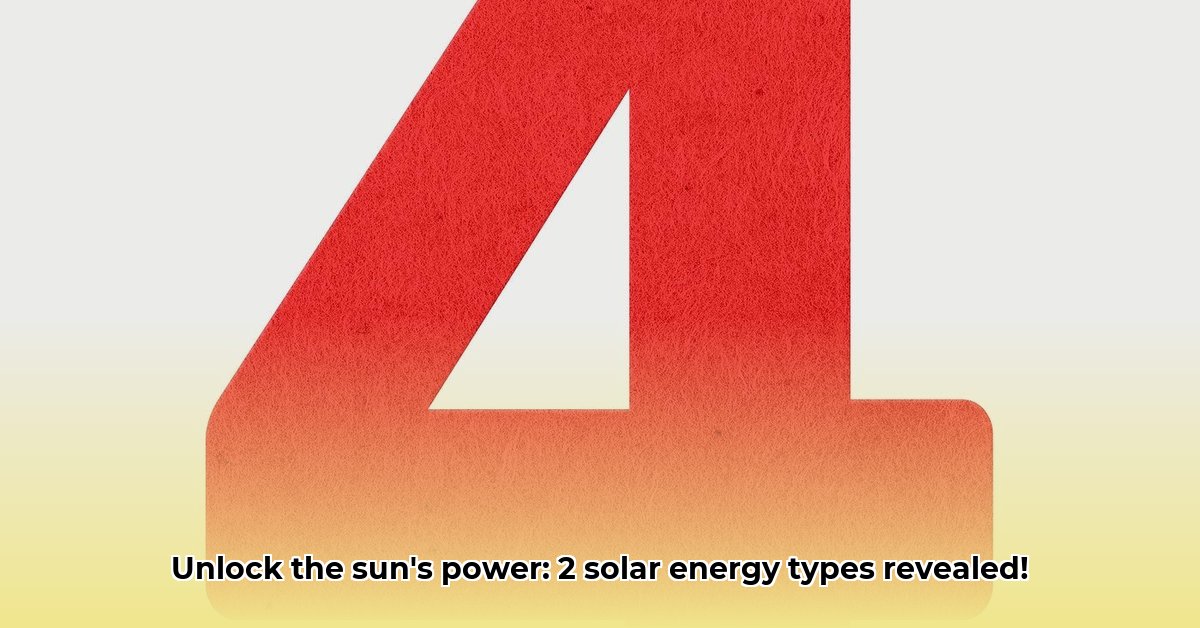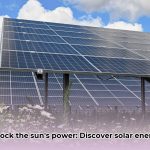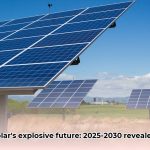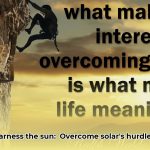Want to go solar? Great! But did you know there are primarily two main ways to harness the sun’s power for electricity? This guide breaks down photovoltaic (PV) and concentrated solar power (CSP) systems in simple terms. We’ll compare how they work, their costs, environmental impact, suitability for diverse applications, and which might be best for you – whether you’re looking to power your home, business, or a whole community. Think of it as your guide to making smart choices about solar energy and securing a cleaner, greener future. We’ll cut through the technical jargon and focus on the practical information you need to understand this exciting and rapidly evolving technology. For more on solar energy limitations, see [solar drawbacks](https://txgenco.com/what-are-two-drawbacks-of-solar-energy).
Decoding Solar Energy Systems: Understanding PV and CSP Technologies
The sun: a giant, natural powerhouse constantly radiating energy. We’re getting better and better at capturing its energy, and two main approaches dominate the field: photovoltaic (PV) and concentrated solar power (CSP). They’re both solar, but they work in vastly different ways. Let’s take a closer look, uncover which might be best for your needs, and explore the core differences in solar energy systems.
Photovoltaic (PV) Systems: Sunlight Straight to Electricity
Imagine tiny solar batteries (photovoltaic cells) packed together on a panel. That’s basically a PV system. Sunlight hits the panel and zap – electrons are energized, creating electricity! These electrons flow through circuits, powering devices or feeding into the electrical grid. Think of those solar panels you see on rooftops or sprawling solar farms. They’re relatively straightforward to set up and maintain, and their modularity allows for flexible configurations, making them a popular choice for homes, businesses, and massive utility-scale projects. However, their performance can be a little finicky. Cloudy days? Lower output. Shading from trees or buildings? Same story. Did you know that PV systems are becoming increasingly efficient and cost-effective, with some panels now exceeding 22% efficiency in converting sunlight to electricity and prices dropping dramatically over the past decade?
Pros of PV Systems:
- Lower upfront costs: Generally, PV systems are cheaper to install initially compared to CSP, making them accessible to a wider range of consumers and businesses.
- Easy installation and maintenance: Their modular design simplifies installation and repair. Damaged panels can be replaced individually, minimizing downtime and maintenance costs. It’s like Lego, but with electricity!
- Versatile applications: They scale exceptionally well, from powering small electronic devices and charging stations to massive solar farms that feed electricity to entire cities.
- Decentralized power: PV panels can generate electricity right where it’s needed – on your roof, integrated into building facades, in remote off-grid locations, wherever! This reduces transmission losses and increases energy independence.
- Quiet operation: PV systems operate silently, with no moving parts, minimizing noise pollution.
Cons of PV Systems:
- Efficiency limitations: While steadily improving, PV efficiency is still lower than CSP systems in areas with consistently strong, direct sunlight.
- Weather dependence: Cloudy skies, shadows, and even dust accumulation can significantly reduce their effectiveness, requiring careful site selection and regular cleaning.
- Land use considerations: While individual panels have a small footprint, large-scale projects can require a significant amount of land, potentially impacting ecosystems and land use patterns.
- Intermittency: PV systems only generate electricity when the sun is shining, requiring energy storage solutions or grid integration to ensure a continuous power supply.
- Manufacturing impacts: The production of PV panels involves energy-intensive processes and the use of certain materials, raising concerns about environmental impacts and supply chain sustainability.
Concentrated Solar Power (CSP) Systems: Heat to Electricity – The High-Power Approach
CSP systems are a different animal entirely. Instead of directly converting sunlight, they use mirrors or lenses – think giant magnifying glasses called heliostats or parabolic troughs – to focus a large area of sunlight onto a central receiver. This concentrated sunlight generates intense heat, often enough to boil water and create high-pressure steam. That steam, in turn, spins turbines connected to generators, producing electricity. It’s like a highly concentrated, sun-powered steam engine! CSP systems really shine in areas with lots of consistent, direct sunshine (deserts are ideal), and they tend to need less land per unit of energy generated compared to PV systems (especially when coupled with thermal energy storage). The initial investment, however, is more substantial.
Pros of CSP Systems:
- Higher efficiency potential: In areas with abundant and direct sunlight, CSP can boast higher efficiency than PV systems, maximizing energy production from a given area.
- Energy storage capabilities: Unlike many PV systems, CSP lends itself well to incorporating thermal energy storage (TES), meaning they can continue generating power even when the sun isn’t shining. Think of it like a solar battery that stores heat in molten salt or other media. This “dispatchability” is a major advantage for grid stability.
- Land efficiency: For large-scale projects, CSP often requires less land compared to PV for the same amount of energy produced, especially when thermal storage is included, as the plant can operate for longer hours.
- Potential for multiple uses: The intense heat generated can be used for other things besides electricity generation, like industrial process heat, desalination, or enhanced oil recovery.
- Long lifespan: CSP plants are designed for long operational lifespans, often exceeding 30 years, providing a reliable source of renewable energy.
Cons of CSP Systems:
- High initial investment: CSP systems are significantly more expensive to build than PV systems due to the complex infrastructure and specialized components required.
- Geographic limitations: They are best suited for consistently sunny, arid climates with high direct normal irradiance (DNI); they don’t perform as well in cloudy regions or areas with diffuse sunlight.
- Complex technology: The technology is more intricate, requiring specialized expertise for design, installation, operation, and maintenance.
- Water usage: Some CSP technologies require significant amounts of water for cooling, which can be a concern in arid regions. Dry-cooling systems can reduce water consumption but increase costs.
- Environmental impacts: CSP plants can have environmental impacts related to land use, habitat disruption, and potential spills of heat transfer fluids.
PV vs. CSP: A Side-by-Side Comparison of Solar Technologies
| Feature | Photovoltaic (PV) | Concentrated Solar Power (CSP) |
|---|---|---|
| Energy Conversion | Direct sunlight to electricity | Concentrated sunlight to heat, then electricity |
| Efficiency | Moderate (15-22%), weather-dependent | High potential (up to 40% or higher), dependent on consistent direct sunshine |
| Cost | Lower initial cost, potentially higher long-term operational costs | Higher initial cost, potentially lower long-term operational costs due to energy storage |
| Scalability | Highly scalable, from small residential to very large utility-scale projects | Primarily large-scale, utility-level projects |
| Applications | Homes, businesses, utility-scale power plants, remote power | Utility-scale power plants, industrial processes, desalination |
| Land Use | Can require significant land for large projects | Potentially more land-efficient for large-scale deployment, especially with thermal storage |
| Energy Storage | Requires separate battery systems | Inherent thermal energy storage (TES) capabilities |
| Geographic Suitability | More flexible, can be deployed in a wider range of climates | Best suited for arid, sunny regions with high direct normal irradiance (DNI) |
Choosing the Right Solar Technology: The Future is Bright (and Sunny!)
Both PV and CSP technologies are constantly improving. Researchers are developing more efficient panels, better mirrors, advanced tracking systems, and smarter ways to store energy. We may even see hybrid systems combining the best features of both technologies. The “best” type of solar depends on many factors, including location, budget, energy demands, grid infrastructure, and environmental considerations. But one thing’s clear: solar energy is a powerful tool, and both PV and CSP are playing vital roles in building a cleaner, more sustainable future. The journey of solar energy development is ongoing, and future advancements might reshape our current understanding of the ideal applications for each technology. Did you know that advancements in materials science are leading to the development of flexible and transparent solar cells, potentially revolutionizing how and where we generate solar power? Perovskite solar cells, for example, promise higher efficiencies and lower manufacturing costs than traditional silicon-based cells.
Levelized Cost of Energy: Comparing PV and CSP Solar Energy System Costs and Efficiency
Let’s dive deeper into the economics of solar power, exploring the financial aspects of the two major players: photovoltaic (PV) and concentrated solar power (CSP) systems. Which one offers the most cost-effective solution for generating clean electricity? It’s not a simple answer, as each shines in different scenarios and depends heavily on specific project parameters.
Understanding PV and CSP Solar Basics
PV systems, the familiar solar panels on rooftops and in solar farms, directly convert sunlight into electricity using photovoltaic cells. Think of them as quiet, solid-state solar energy converters. CSP, on the other hand, uses mirrors or lenses to focus sunlight onto a central receiver, generating high-temperature heat that drives a turbine
- Hydro Extrusions USA Leads North American Aluminum Profile Solutions - December 28, 2025
- Hydro North America Leads Aluminum Extrusion Solutions Across Diverse Industries - December 27, 2025
- Hydro Extrusion North America Provides Custom Solutions Across Diverse - December 26, 2025
















